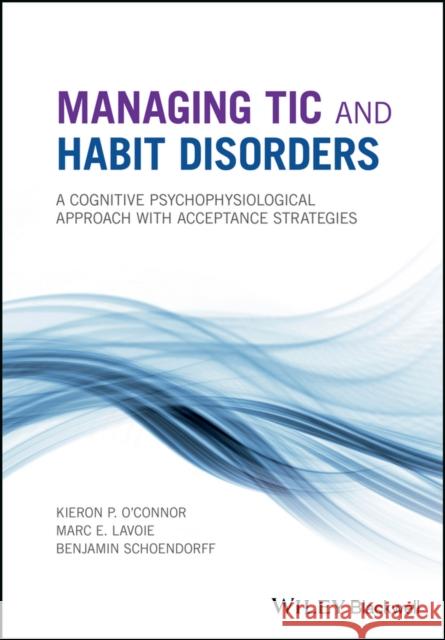Managing Tic and Habit Disorders: A Cognitive Psychophysiological Treatment Approach with Acceptance Strategies » książka



Managing Tic and Habit Disorders: A Cognitive Psychophysiological Treatment Approach with Acceptance Strategies
ISBN-13: 9781119167273 / Angielski / Miękka / 2018 / 208 str.
Managing Tic and Habit Disorders: A Cognitive Psychophysiological Treatment Approach with Acceptance Strategies
ISBN-13: 9781119167273 / Angielski / Miękka / 2018 / 208 str.
(netto: 204,30 VAT: 5%)
Najniższa cena z 30 dni: 213,19
ok. 30 dni roboczych
Dostawa w 2026 r.
Darmowa dostawa!
A Cognitive Psychophysiological Treatment Approach with Acceptance Strategies.
Wydanie ilustrowane
List of Tables and Figures ix
List of Contributors xiii
Acknowledgments xv
About the Companion Web Site xvii
Introduction 1
1 The Nature of Tics and Habits 9
Overview of the Nature of Tics and Habits 9
Idea of a Tourette or Tic and Habit Spectrum 10
Current Diagnostic Criteria of Tics and Habits 10
Current Multidimensional Etiology of Tics and Habits 13
Social Impact and Consequences 17
Current Treatment Options 18
2 Evaluation and Assessment 21
Evaluation and Assessment: What are Tics and Habits? 21
Evaluating the Severity of Tics and Habits and Their Impact on the Client s Life 22
Assessing Style of Planning and Thinking and Beliefs about Tics
or Habits 32
3 Motivation and Preparation for Change 43
Motivation: Ready to Change the Habit 43
The Pros and Cons of Tics and Habits; and Setting Goals and How to Attain Them 50
Client s Perception of the Tic or Habit 52
Dealing with Stigma and Self–stigma 53
Control: Micro– and Macro–control 55
The Contextual Nature of Tic or Habit Onset 57
4 Developing Awareness 61
Choosing and Describing the Tic or Habit 61
Awareness of the Tic or Habit 63
Discovery of Seeing the Habit Differently 63
Discovery Exercises 64
Making a Video: Replaying and Watching the Video 64
Premonitory Signs 67
Daily Diary 68
Tic or Habit Variations 73
Tics or Habits in Context 74
5 Identifying At–Risk Contexts 77
Identifying Variations in the Context of the Tics or Habits 77
Discovering High and Low Risk Situations or Activities 78
Evaluating the Situation or Activity 79
Linking High Risk Activities and Evaluations to Feelings and Thoughts and Assumptions 83
6 Reducing Tension 87
Tension Before Ticking: How to Use Your Muscles 87
Conflicting Preparation Versus Coherent Preparation 92
Unhelpful Attempts at Self–management of Tics or Habits 95
Mindful Engagement 96
Mindfulness Exercises 97
7 Increasing Flexibility 101
Discriminating Muscle Contractions 101
Rationale and Procedure for Discrimination Exercises 102
Whole Body Muscle Control 105
Muscle Relaxation 105
Check the Breathing, Posture, and Flow During Movement 106
Breathe Better 106
Relaxation Exercises 107
Refocusing Sensations 111
8 Addressing Styles of Planning Action 115
Style of Planning: Pulling Together Sensory, Emotional, and Motor Aspects of Ticking 115
Styles of Action 116
Behavioral Cost 118
Thoughts associated with Styles of Action: Perfectionism in Personal Standards and Personal Organization 120
9 Experiential Avoidance, Cognitive Fusion, and the Matrix 127
Experiential Avoidance and Cognitive Fusion 127
Improving Flow and Goal Directed Action Using the ACT Matrix 131
Discriminating Thoughts, Actions, and Experiences 134
Using the ACT Matrix to Work with Styles of Action 137
10 Emotional Regulation and Overcoming the Habit Shame Loop 141
The Habit Shame Loop 145
Adaptive and Maladaptive Coping 146
Validating Emotion 147
Working with Self–talk 148
Relational Frame Theory 149
An RFT–inspired Link between Dysfunctional Thoughts and Tension 152
11 Achieving Goals and Maintaining Gains 155
Maintaining the New Behavior 155
New Situations 158
Reward and Self–compassion 159
Relapse Prevention 160
Achieving Non–tic Goals 160
Finally 161
References 163
Index 171
Kieron O′Connor, PhD, is currently director of the OCD Spectrum Study Centre at the University Institute of Mental Health at Montreal, and Centre Integré Universitaire de Santé et de Service Sociaux de L′Est de l′Ile de Montreal. He is also Full Professor at the Psychiatry Department of the University of Montreal and affiliated professor at the University of Quebec.
Marc E. Lavoie, PhD, is a professor of psychiatry and neuroscience at the University of Montréal and is currently head of the Cognitive and Social Psychophysiology laboratory at the research center of the Institut Universitaire en Santé Mentale de Montréal.
Benjamin Schoendorff, MA, MSc, is a clinical psychologist and director of the Contextual Psychology Institute in Montreal, Canada.
A pioneering guide for the management of tics and habit disorders
Managing Tic and Habit Disorders: A Cognitive Psychophysiological Approach with Acceptance Strategies is a complete client and therapist program for dealing with tics and habit disorders. Groundbreaking and evidence–based, it considers tics and habit disorders as part of the same spectrum and focuses on the personal processes that are activated prior to a tic or habit rather than the tic or habit itself. By drawing on acceptance and mindfulness strategies to achieve mental and physical flexibility in preparing action, individuals can release unnecessary tension, expend less effort and ultimately establish control over their tic or habit.
The authors explain how to identify the contexts of thoughts, feelings and activities that precede tic or habit onset, understand how self–talk and language can trigger tic onset, and move beyond unhelpful ways of dealing with emotions – particularly in taking thoughts about emotions literally. They also explore how individuals can plan action more smoothly by drawing on existing skills and strengths, and overcome shame by becoming less self–critical and more self–compassionate. They conclude with material on maintaining gains, developing new goals, and creating a more confident and controlled lifestyle.
Managing Tic and Habit Disorders is a thoughtful and timely guide for those suffering from this sometimes all–consuming disorder, and the professionals who set out to help them.
1997-2025 DolnySlask.com Agencja Internetowa
KrainaKsiazek.PL - Księgarnia Internetowa









